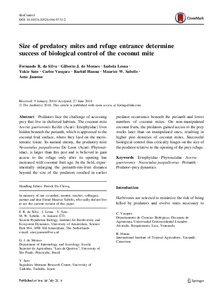| dc.contributor.author | Silva, F.R. da |
| dc.contributor.author | Moraes, G.J. de |
| dc.contributor.author | Lesna, I. |
| dc.contributor.author | Sato, Y. |
| dc.contributor.author | Vásquez, C. |
| dc.contributor.author | Hanna, R. |
| dc.contributor.author | Sabelis, M.W. |
| dc.contributor.author | Janssen, A. |
| dc.date.accessioned | 2019-12-04T11:04:06Z |
| dc.date.available | 2019-12-04T11:04:06Z |
| dc.date.issued | 2016 |
| dc.identifier.citation | da Silva, F.R., de Moraes, G.J., Lesna, I., Sato, Y., Vasquez, C., Hanna, R., ... & Janssen, A. (2016). Size of predatory mites and refuge entrance determine success of biological control of the coconut mite. BioControl, 1-9. |
| dc.identifier.issn | 1386-6141 |
| dc.identifier.uri | https://hdl.handle.net/20.500.12478/1340 |
| dc.description | Published online: 06 July 2016 |
| dc.description.abstract | Predators face the challenge of accessing prey that live in sheltered habitats. The coconut mite Aceriaguerreronis Keifer (Acari: Eriophyidae) lives hidden beneath the perianth, which is appressed to the coconut fruit surface, where they feed on the meristematic tissue. Its natural enemy, the predatory mite Neoseiuluspaspalivorus De Leon (Acari: Phytoseiidae), is larger than this pest and is believed to gain access to the refuge only after its opening has increased with coconut fruit age. In the field, experimentally enlarging the perianth-rim-fruit distance beyond the size of the predators resulted in earlier predator occurrence beneath the perianth and lower numbers of coconut mites. On non-manipulated coconut fruits, the predators gained access to the prey weeks later than on manipulated ones, resulting in higher pest densities of coconut mites. Successful biological control thus critically hinges on the size of the predator relative to the opening of the prey refuge. |
| dc.format.extent | 1-9 |
| dc.language.iso | en |
| dc.subject | Eriophyidae |
| dc.subject | Phytoseiidae |
| dc.subject | Aceria Guerreronis |
| dc.subject | Perianth |
| dc.subject | Coconuts |
| dc.subject | Biological Control |
| dc.title | Size of predatory mites and refuge entrance determine success of biological control of the coconut mite |
| dc.type | Journal Article |
| dc.description.version | Peer Review |
| cg.contributor.crp | Integrated Systems for the Humid Tropics |
| cg.contributor.affiliation | University of Amsterdam |
| cg.contributor.affiliation | University of São Paulo |
| cg.contributor.affiliation | University of Tsukuba |
| cg.contributor.affiliation | Universidad Centroccidental Lisandro Alvarado |
| cg.contributor.affiliation | International Institute of Tropical Agriculture |
| cg.coverage.region | Africa |
| cg.coverage.region | South America |
| cg.coverage.country | Venezuela |
| cg.researchtheme | PLANT PRODUCTION & HEALTH |
| cg.isijournal | ISI Journal |
| cg.authorship.types | CGIAR and developing country institute |
| cg.iitasubject | Pests Of Plants |
| cg.iitasubject | Plant Health |
| cg.journal | BioControl |
| cg.howpublished | Formally Published |
| cg.accessibilitystatus | Open Access |
| local.dspaceid | 79288 |
| cg.targetaudience | Scientists |
| cg.identifier.doi | https://dx.doi.org/10.1007/s10526-016-9751-2 |

